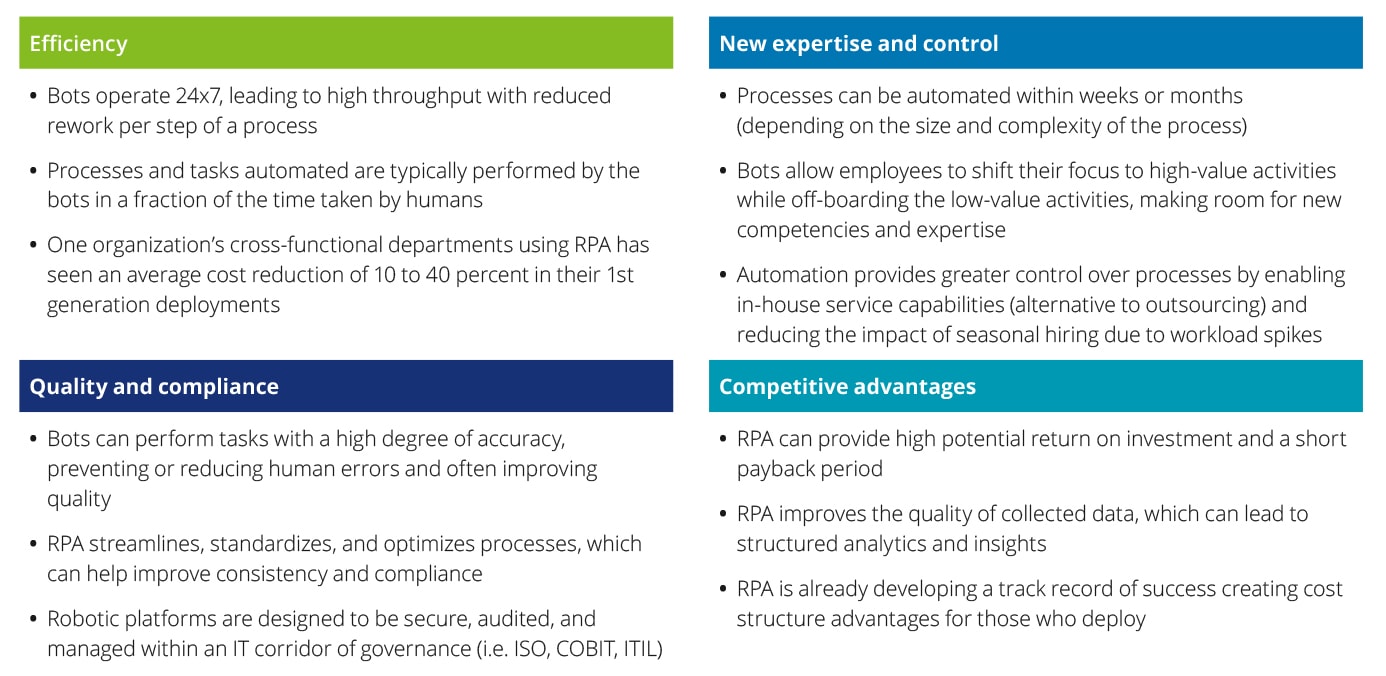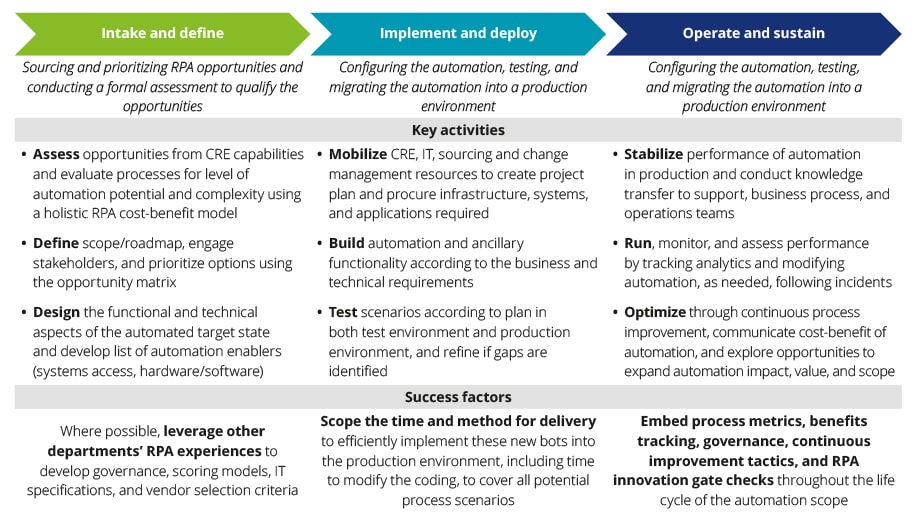Robotic process automation in corporate real estate and facilities management has been saved

Perspectives
Robotic process automation in corporate real estate and facilities management
Digital management applications of RPA in CRE and FM
Robotic process automation (RPA) is changing the way businesses are run, and soon it will change the way corporate real estate (CRE) and facilities management (FM) organizations are run. Are you ready?
Explore content
- Endless possibilities of RPA
- What is RPA and what does it do well?
- Where can CRE and FM organizations leverage RPA?
- How does RPA create value?
- Real-world RPA success stories within CRE & FM
Endless possibilities of RPA in corporate real estate and facilities management
Imagine a future where:
- Your corporate real estate and facilities management (CRE and FM) time and talent are maximized
- Your team is focused on strategic insights and decisions, rather than on routine tasks
- CRE and FM data is harnessed real-time to understand how your portfolio, sites, and organization are performing
- Disparate data sources and systems are interconnected and optimized
Far from being an alternate reality, your CRE and FM organization could be applying digital management strategies to operate this way now with the help of RPA. RPA is a tool that can help CRE and FM organizations drive improved performance by automating repetitive manual tasks traditionally performed by humans.
Here we address several questions commonly asked by CRE & FM organizations:
- What is RPA and what does it do well?
- Where can CRE and FM organizations leverage RPA?
- How does RPA create value?
- What are some examples of RPA implementations in CRE and FM?
- What are the elements of a realistic and executable RPA roadmap?
Keep reading below to learn more, and download part one and part two of our article series that explores each of these questions in more depth.
What is RPA and what does it do well?
RPA involves the deployment of software robots, called “bots,” to lower the cost and increase the effectiveness of routine clerical processes. RPA bots are most effective when the tasks and processes they perform have the following five key attributes: highly transactional, time-consuming, highly scalable, low-complexity rules, and highly standardized.
For CRE and FM organizations, the RPA capabilities could be transformative too. Many CRE and FM organizations today have more business processes, data, systems, technologies, and regulatory requirements than ever before, but they don’t have expanded IT budgets and personnel to absorb the extra work.
As an alternative, governed by pre-defined rules, RPA solutions can perform routine, repetitive clerical tasks. By deploying bots to handle such tasks, CRE and FM organizations can reduce operating costs while reassigning personnels' responsibilities to higher value tasks. RPA can become the foundation for more sophisticated digital management applications, such as cognitive automation and machine learning, which can augment human decision-making and take on more complex tasks. RPA can be embedded in traditional business operating models, where bots could perform tasks, such as:
|
Receiving and collating data via email/workflow |
Copying, pasting, and inspecting data |
|
|
Moving files and folders |
Logging into web and enterprise applications |
|
|
Filling in forms and transferring data to templates or systems |
Mining and extracting data from the web |
|
Performing calculations and pre-defined adjustments |
Extracting structured data from documents and source systems, and uploading, emailing, and reporting information |
||
|
Collecting social media statistics |
Where can CRE and FM organizations leverage RPA?
The suitability of RPA “bots” for a given process is expressed in terms of the percentage of tasks or steps, within an end-to-end process, that can be automated:
- High-RPA suitability: more than 70 percent of steps in the process can be automated
- Medium-RPA suitability: 30 to 70 percent of steps can be automated
- Low-RPA suitability: fewer than 30 percent of steps can be automated
The chart below presents the RPA suitability heat map for selected CRE and FM processes.
At the task level, some notable examples are:
- Maintaining a real estate portfolio with up-to-date space, occupancy, and cost data
- Uploading data to an integrated workplace management system (IWMS) or other digital management or portfolio management tools
- Assembling and organizing performance management data from multiple disparate systems to create regular reports
- Managing additions, edits, and deletions in security and building access systems
- Compiling utility bills, occupancy data, and weather reports to assess energy consumption and management
- Creating standard contracts for leases and constructions bids, especially those involving large numbers of vendors
- Maintaining customer and vendor data
Real-world RPA success stories within CRE & FM
A large multinational organization undertook an organization-wide evaluation to understand some of the highly manual and repetitive tasks prone to error and inefficiency. One of the key processes identified as a potential automation candidate was property tax billing for large equipment customer leases. The organization pays property tax on behalf of tens of thousands of its customers. The ability to recover property tax from each customer was a manual effort that took thousands of hours per year in processing, submission, validation, and tracking time.
The organization had less than a 50 percent success rate in prior years in processing those bills because the process was highly fragmented, cumbersome, and inconsistent. The entire process from data extraction to customer billing and reporting was determined to be fully automated using RPA.
Deloitte supported the design of the automation, which took one week; the build of the bot, which took ten weeks to complete; and deployment into production, which resulted in:
— Increased efficiency: reduced the time taken for customer reporting, data extraction, and data manipulation from 45 hours per month down to only one hour
— Increased control: completely removed the need for seasonal FTE support during peak processing times for month and quarter end
— Shift in human focus: redeployed more than five FTEs that were previously dedicated to manual customer billings
— Increase in revenue: achieved 100 percent billing for all eligible customer property expenses in a standardized and repeatable process
Many CRE & FM organizations use IWMS to manage real estate portfolios, infrastructure, and facilities’ assets. Maintaining an up-to-date master database is a critical task of IWMS platforms and sometimes a difficult task when it comes to project and facilities maintenance monitoring, status updates, budget approvals, and decisions for all up-coming and in-flight construction.
To execute projects on-time and on-budget, access and real-time updates to location and contacts data are required for the sites with upcoming or in-flight projects. CRE & FM organizations typically deploy dedicated personnel to update and maintain the portfolio database, since it is a repetitive and manual task.
Deloitte assisted a global CRE & FM organization in automating the tracking and management of thousands of portfolio records to enable personnel to focus on more value-add activities. The automation allowed for:
— Reduction in IT costs: reduced cost of implementing IWMS, as it can be deployed as an out-of-the-box solution rather than attempting to customize it to handle portfolio data management
—Increased efficiency: improved efficiency of non-customized IWMS, with faster processing and reduction in errors due to complex coding, software patches, and system upgrades
— Improved quality and standardization: reduced entry errors, resulting in accurate, consistent, and up-to-date data
— Shift in human focus: freed up resources to handle more complex tasks since the bots can handle daily data management tasks
What are the elements of a realistic and executable RPA roadmap for CRE & FM?
A successful RPA transformation begins with a holistic vision of what activities and resources are required, and how they are sequenced and organized.
CRE & FM organizations can start the RPA journey by:
- Intaking RPA opportunities and defining the possible cost-benefits across processes
- Implementing a detailed project plan to build bots and then deploying through a robust testing protocol
- Operating the automated process and sustaining value through a continuous performance methodology
Below are some broad steps for deployment; to help increase the effectiveness of the adoption roadmap, we have noted some key activities and success factors for each step.
Now is the time: An RPA call-to-action for CRE and FM
RPA represents an exciting opportunity for CRE & FM organizations to reduce costs and drive higher levels of performance. Thanks in part to other enabling functions, which are already leveraging RPA to impact both cost and quality across large scale deployments, CRE & FM organizations can become “fast followers” in the RPA movement.
RPA is a readily available capability with the potential to create a significant shift in a CRE & FM organization’s cost structure while improving responsiveness to internal client demands. As part of a broader journey, RPA can also lead CRE & FM organizations to use analytics and machine learning capabilities, leveraging data from across the enterprise to improve operations, occupancy levels, service delivery, and workplace experience.
The future is now. It’s time to get started.

Let's talk
Contact us to learn more about the benefits and opportunities of RPA in corporate real estate and facilities management.
Darin Buelow |
Abby Levine |
David Kaplan |
Recommendations
Real estate expectations and market realities
Identifying opportunities in a changing landscape



